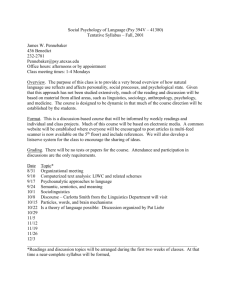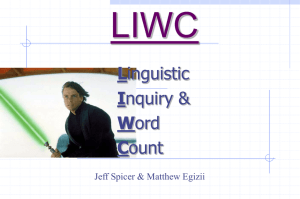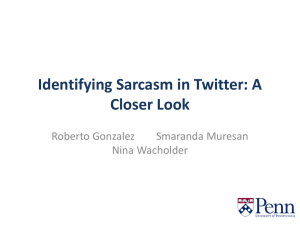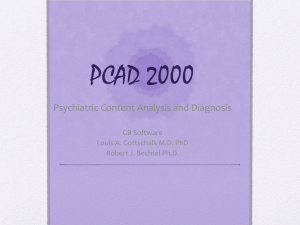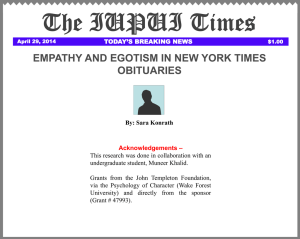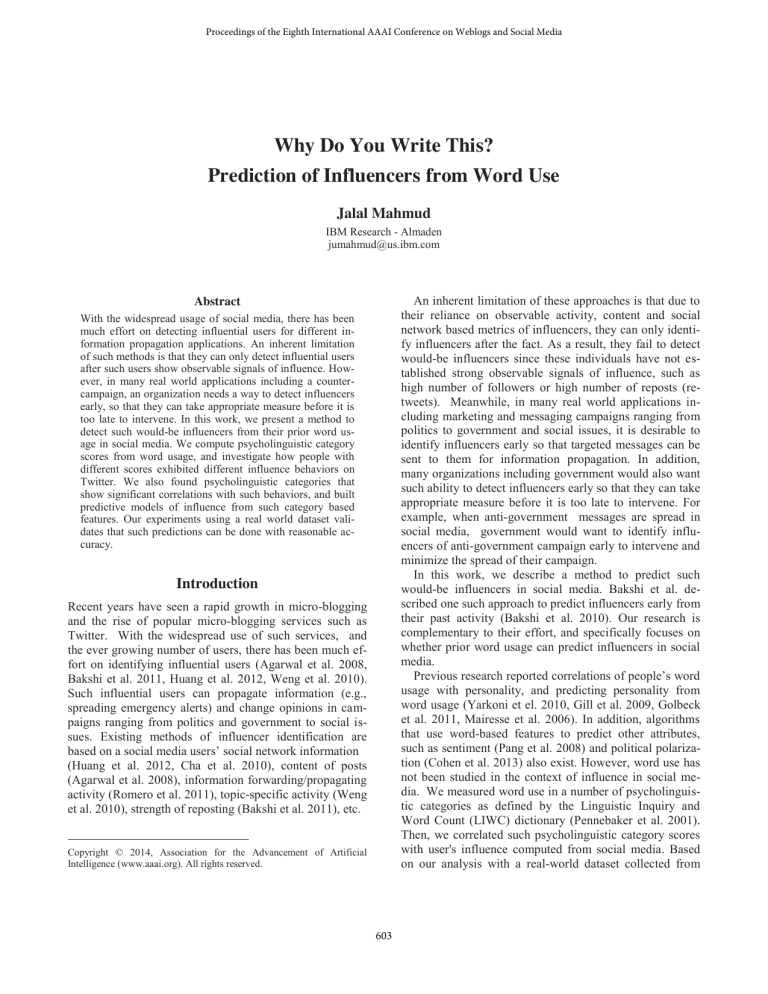
Proceedings of the Eighth International AAAI Conference on Weblogs and Social Media
Why Do You Write This?
Prediction of Influencers from Word Use
Jalal Mahmud
IBM Research - Almaden
jumahmud@us.ibm.com
An inherent limitation of these approaches is that due to
their reliance on observable activity, content and social
network based metrics of influencers, they can only identify influencers after the fact. As a result, they fail to detect
would-be influencers since these individuals have not established strong observable signals of influence, such as
high number of followers or high number of reposts (retweets). Meanwhile, in many real world applications including marketing and messaging campaigns ranging from
politics to government and social issues, it is desirable to
identify influencers early so that targeted messages can be
sent to them for information propagation. In addition,
many organizations including government would also want
such ability to detect influencers early so that they can take
appropriate measure before it is too late to intervene. For
example, when anti-government messages are spread in
social media, government would want to identify influencers of anti-government campaign early to intervene and
minimize the spread of their campaign.
In this work, we describe a method to predict such
would-be influencers in social media. Bakshi et al. described one such approach to predict influencers early from
their past activity (Bakshi et al. 2010). Our research is
complementary to their effort, and specifically focuses on
whether prior word usage can predict influencers in social
media.
Previous research reported correlations of people’s word
usage with personality, and predicting personality from
word usage (Yarkoni et el. 2010, Gill et al. 2009, Golbeck
et al. 2011, Mairesse et al. 2006). In addition, algorithms
that use word-based features to predict other attributes,
such as sentiment (Pang et al. 2008) and political polarization (Cohen et al. 2013) also exist. However, word use has
not been studied in the context of influence in social media. We measured word use in a number of psycholinguistic categories as defined by the Linguistic Inquiry and
Word Count (LIWC) dictionary (Pennebaker et al. 2001).
Then, we correlated such psycholinguistic category scores
with user's influence computed from social media. Based
on our analysis with a real-world dataset collected from
Abstract
With the widespread usage of social media, there has been
much effort on detecting influential users for different information propagation applications. An inherent limitation
of such methods is that they can only detect influential users
after such users show observable signals of influence. However, in many real world applications including a countercampaign, an organization needs a way to detect influencers
early, so that they can take appropriate measure before it is
too late to intervene. In this work, we present a method to
detect such would-be influencers from their prior word usage in social media. We compute psycholinguistic category
scores from word usage, and investigate how people with
different scores exhibited different influence behaviors on
Twitter. We also found psycholinguistic categories that
show significant correlations with such behaviors, and built
predictive models of influence from such category based
features. Our experiments using a real world dataset validates that such predictions can be done with reasonable accuracy.
Introduction
Recent years have seen a rapid growth in micro-blogging
and the rise of popular micro-blogging services such as
Twitter. With the widespread use of such services, and
the ever growing number of users, there has been much effort on identifying influential users (Agarwal et al. 2008,
Bakshi et al. 2011, Huang et al. 2012, Weng et al. 2010).
Such influential users can propagate information (e.g.,
spreading emergency alerts) and change opinions in campaigns ranging from politics and government to social issues. Existing methods of influencer identification are
based on a social media users’ social network information
(Huang et al. 2012, Cha et al. 2010), content of posts
(Agarwal et al. 2008), information forwarding/propagating
activity (Romero et al. 2011), topic-specific activity (Weng
et al. 2010), strength of reposting (Bakshi et al. 2011), etc.
Copyright © 2014, Association for the Advancement of Artificial
Intelligence (www.aaai.org). All rights reserved.
603
Twitter, we have found statistically significant correlations
of several psycholinguistic categories with influence. Furthermore, we have built predictive models from psycholinguistic category features for predicting influence score
of a Twitter user. Our experiments validate that such predictions can be done with reasonable accuracy.
This paper is organized as below. We present a brief
overview of influence measurement in previous research,
and our approach in the next section. Then, we describe
our dataset for this work. Next, we describe how we conduct psycholinguistic analysis with LIWC dictionary. The
following sections describe the correlation of influence behavior with LIWC categories, and predictive model of influence from LIWC categories. Finally, we discuss the
findings and conclude the paper.
Psycholinguistic Analysis from text
Motivated by prior works on personality prediction from
text (Golbeck et al. 2011, Yarkoni et al. 2010, Gill et al.
2009, Mairesse et al. 2006), we measured word uses in users' historical tweets with the Linguistic Inquiry and Word
Count (LIWC) 2001 dictionary (Pennebaker et al. 2001).
LIWC is the most commonly used language analysis tool
for investigating the relation between word use and psychological variables (Pennebaker et al. 2001). LIWC 2001
defines over 70 different categories, each of which contains several dozens to hundreds of words (Pennebaker et
al. 2001). We excluded the categories that are nonsemantic (e.g., proportion of long words) or relevant to
speech (e.g. fillers) and considered the remaining 66 LIWC
categories. For each person, we computed his/her LIWCbased scores in each category as the ratio of the number of
occurrences of words in that category in one’s tweets and
the total number of words in his/her tweets. We excluded
retweets when computing LIWC-based category scores,
because retweets are content generated by others.
Measuring Influence
Researchers have proposed various measures of influence.
Bakshi et al. measured influence by a user’s ability to seed
content containing URLs that generate large cascades of
reposts (retweets) (Bakshi et al. 2011). To identify consistently influential users, they aggregated all URL posts by
user and computed individual-level influence as the logarithm of the average size of all cascades for which that user
was a seed. Cha et al. proposed three measures of user influence in Twitter: the number of followers of a user, the
number of retweets containing user's name and number of
mentions containing user's name (Cha et al. 2010). Weng
et al. measured user's influence using topic-specific page
rank approach (Weng et al. 2010). Romero et al. designed
an algorithm which considers pair-wise influence relationships among users and user's passivity (a measure of how
difficult for other users to influence the user) to assign influence score of Twitter users (Romero et al. 2011). Motivated by Bakshi et al. and Cha et al., we measure influence
score by the average number of retweets generated from a
user's tweets.
Influence and Word Use
In this analysis, we correlate the LIWC category scores
with influence score, and use the correlation significance to
measure reliability. This analytical approach was used to
identify associations between personality and word use
(Golbeck et al. 2011, Yarkoni et al. 2010, Gill et al. 2009).
Thus, we begin by running a two-tailed Pearson correlation
analysis between users' LIWC category scores and users
influence score. The statistically significant correlations
are shown in Table 1.
Dataset
We used Twitter's streaming API from Nov 1, 2013 to Nov
14, 2013 to randomly sample 1000 users. We crawled their
tweets from last one month (Oct 2013) and denoted them
as recent tweets. We also crawled users' historical tweets
(max 200) before last one month (until Oct 2013), and denoted them as historical tweets. There were 134857 historical tweets in total. We obtained total number of retweets
generated by each tweet in users' recent tweets using Twitter's REST API. Next, we computed influence score of
each user from their recent tweets, where influence score
of a user is the average number of retweets generated by
his recent tweets from Oct 1, 2013 until Nov 14, 2013.
Average influence score was 0.213, and standard deviation
was 0.098.
LIWC categories
Correlation
Anger
Anxiety
Swear Words
Communication
Cognition
Perception
Social Process
Friends
Humans
Positive Feelings
Positive Emotions
Negative emotion
Discrepancy
Inclusive
Physical States
Inhibition
Insight
Certainty
-0.213
-0.114
-0.198
0.164
0.103
0.152
0.167
0.171
0.118
0.215
0.179
-0.191
0.221
0.172
-0.153
-0.184
0.193
0.167
Significance
Level
**
*
*
**
*
*
**
*
*
**
*
**
*
*
*
*
*
*
Table 1. Statistically significant correlations (* means p < 0.05,
** means p < 0.01) of LIWC categories with influence
604
Independent
variables
used
All LIWC categories
LIWC categories with
significant correlations
gory inclusive, containing words such as along and also, is
also more likely to be influencer. This category is intuitively related with people who are more social and friendly,
and it follows that people who scores high also seem to be
influencer. The LIWC category physical states has significant negative correlations with influence behavior. This
category represents words such as diabetes, disease, dizziness, and sleep. These words often indicate someone’s
sickness or inactivity. This may indicate apathy on the part
of the user, which would make them less likely to be influencer. LIWC category inhibition (represents words such as
shy, unease, retard) also negatively correlated with influence behavior.
The LIWC category insight is represented by words such
as think, know, consider. We found a significant positive
correlation of this category with influence behavior. Similarly, LIWC category certainty (exemplified by words such
as fact, confidence, always) is positively correlated with influence.
Mean Absolute Error
(MAE)
0.269
0.223
Table 2. Regression results over a 10-fold cross validation
Features Used
All LIWC categories
LIWC categories with
significant correlations
Recall
0.82
0.88
Precision
0.79
0.91
F1
0.804
0.895
Table 3. Binary Classification Results over 10-fold cross validation
Features Used
All LIWC categories
LIWC categories with
significant correlations
Recall
0.721
0.775
Precision
0.744
0.813
F1
0.732
0.793
Table 4. Classification Results over 10-fold cross validation
when 10-influence categories are considered
Prediction Models
LIWC category anger is negatively correlated with influence score which indicates that people who use more angry
words (such as anger, angry) are less likely to be influencer. An anxious person, exhibited by the LIWC category
anxiety and consisting of words such as afraid and alarm,
is less likely to be an influential. Similarly, people who use
swear words (such as damn, piss) are also less likely to be
influencer. These are quite intuitive.
The LIWC category communication is significantly positively correlated with influence, which indicates that more
communicative people are more likely to be influencer.
The LIWC category cognition, exemplified by words
such as accept, acknowledge, admit, and agree, has a significant positive correlation with influence behavior. The
LIWC category perception represents words such as ask,
call, and contact. These words are often used by people
who are more interactive, and the positive correlation indicates that interactive people may be more influential. A social (exemplified by words such as interact, involve) and
friendly (example words are friends, partner, buddy) person are likely to be influencer. Similarly, LIWC category
humans (example words are people, guy, man, girl) is also
positively correlated with influence. An individual with
positive feelings (exemplified by words such as care,
cheer, attachment) and positive emotions (exemplified by
words such as accept and admit) are more likely to be influencer. These are quite intuitive. On the other hand, people who use negative emotion words (such as hurt, ugly,
nasty) are less likely to be an influential.
The LIWC category discrepancy has significant positive
correlations with influence behavior. This represents words
such as expect, hope, need, must, should which may indicate determination and desires for the future. In addition,
we found that a person who scores high in the LIWC cate-
We attempted to build predictive models for influence
score based on the psycholinguistic category features to
understand their predictive power to predict influence
score. We performed both regression analysis and a classification study using WEKA (Hall et al. 2009), a widely
used machine learning toolkit.
For regression analysis, we formulated linear regressions
to predict influence score using LIWC measures. Thus,
LIWC attributes were independent variables of the regression model and users’ influence score was the dependent
variable. We tried a number of regression approaches, including simple linear regression, multiple linear regression,
pace regression, logistic regression and SVM regression.
We performed 10-fold cross validation. SVM regression
slightly outperformed other algorithms.
Table 2 presents the result of the regression analysis in
terms of mean absolute error (MAE). We find that influence score can be predicted within 22.3%-26.9% MAE.
The best result is obtained when LIWC categories with
significant correlations were used as independent variables
in the regression model.
In the classification study, we tried two different settings. In the first setting, we tried supervised binary machine learning algorithms to classify users with abovemedian levels of influence score. In the second setting, we
divide influence scores into 10 equal sized bins, and
trained supervised classifiers with 10 classes.
We experimented with a number of classifiers from
WEKA, including naive Bayes, SMO (an SVM implementation), J48 (a decision-tree-based classifier), Random Forest (an ensemble method that combines multiple decision
trees). Table 3 and 4 show the classification result of the
best WEKA classifier in terms of Recall, Precision and F1
605
under 10-fold cross validation. We see that classifying high
(above median) or low (below median) influencers from
LIWC category based features can be done quite accurately
(89% F1 when significant LIWC categories are used as
features). Accuracy reduces when we considered 10 influencer categories. Prediction difficulty increases with more
class and hence prediction accuracy drops. However, even
with 10 influence categories, our model performs reasonably well (79% F1 with significant LIWC features). For
each setting, best classifier is obtained when LIWC categories with significant correlations are used as features.
that our models are reasonably accurate. We have identified several directions of future work. First, we will extend
our analytics to other social media platforms. Second, we
will verify the generality of the findings with other social
media datasets (e.g., campaign specific dataset). Third, we
will investigate how word use with other activity based
features can predict influence. Fourth, we will investigate
whether topic modeling such as LDA can be useful to
compute features from word use in the prediction model.
Fifth, we will conduct a similar analysis for other measures
of influence (e.g., number of followers gained in a specific
time). Finally, we will integrate our model with a campaign application, and investigate its usage in the real
world.
Discussion
Our findings suggest several implications for social media
research. Our work is the first study that reports correlations of word usage with influence behavior. Our work also
discovers a set of psycholinguistic categories which have
significant correlations with users’ influence in Twitter.
Such psycholinguistic categories are also shown to be useful to predict the influence score of a user. Our findings also suggest that certain word use can predict such likelihoods. For instance, people who use angry words (such as
anger, hate, kill) are less likely to be influencer, people
who write about communication are more likely to be influencer, and people who write about positive feelings are
more likely to be influencer. Predictive models of influencer from prior word usage can identify users early to be
an influencer. This is useful for various information propagation applications including viral marketing (Brown et al.
1987), and social/government/political campaigns (e.g., a
campaign to support “vaccination”). Identifying such influencers early can be also useful to counter their affect.
Our research to identify influencers from prior word use is
orthogonal to existing research on influence modeling
(Agarwal et al. 2008, Bakshy et al. 2011, Cha et al. 2010)
for such applications. Our regression analysis confirms that
such predictions can be done with reasonably low error
(22.3% MAE). Furthermore, our classification study shows
that classifying influencers can be done quite accurately
(89% binary classification accuracy, and 79% classification accuracy with 10-classes). In this study we did not explore ranking algorithms. However, learning-to-rank algorithms (Liu et al. 2009) may be useful to further harness
the predictive information from word use.
References
Agarwal, N., Liu, H., Tang, L., and Yu, P. S. Identifying the influential bloggers in a community. In Proc. WSDM, 2008.
Bakshy, E., Hofman, J. M., Mason, W. A., and Watts, D. J. Everyone's an influencer: quantifying influence on twitter, In Proc.
WSDM, 2011.
Brown, J., Reinegan, P. Social ties and word-of-mouth referral
behavior. Journal of Consumer Research 14:3 (1987), 350-362.
Cha, M., Haddadi, H., Benevenuto, F., and Gummadi, K.P.
Measuring user influence in twitter: The million follower fal-lacy.
In Proc. ICWSM, 2010.
Cohen, R., and Ruths, D. 2013. Classifying Political Orientation
on Twitter: It’s Not Easy!. In ICWSM'13.
Gill, A.J., Nowson, S., Oberlander, J. 2009. What Are They
Blogging About? Personality, Topic and Motivation in
Blogs. In ICWSM'09.
Golbeck, J. Robles, C., Edmondson, M., Turner, K. 2011 Predicting Personality from Twitter. In Proc. IEEE SocialCom. 2011.
Hall, M., Frank, E., Holmes, G., Pfahringer, B., Reutemann, P.,
and Witten, I. The WEKA data mining software: an update. In
ACM SIGKDD newsletter, Vol 11, Issue 1, 2009.
Huang, J., Cheng, X.-Q., Shen, H.-W, Zhou, T., and Jin, X. Ex
ploring social influence via posterior effect of word-of-mouth
recommendations. In Proc. WSDM, 2012.
Liu T. Y. 2009. Learning to rank for information retrieval. Foundations and Trends in Information Retrieval, 3(3), 225-331.
Mairesse, F., Walker, M. 2006. Words Mark the Nerds: Computational Models of Personality Recognition through language, In
Proc. of CogSci 2006.
Pang, B. and Lee, L. 2008. Opinion mining and sentiment analysis. Foundations and Trends in Information Retrieval (2).
Pennebaker, J.W., Francis, M.E., and Booth, R.J. Linguistic Inquiry and Word Count. Erlbaum Publishers, 2001.
Romero. D. M., Galuba. W., Asur. S, and Huberman, B. A. Influence and passivity in social media. In Proc. ECML/PKDD, 2011.
Weng, J. Lim. E.-P., Jiang. J, and He. Q. Twitterrank: Finding
topic-sensitive influential twitterers. In Proc. WSDM, 2010.
Yarkoni, Tal. Personality in 100,000 words: A large-scale analysis of personality and word usage among bloggers. Journal of Research in Personality.
Conclusion
We have presented a study on understanding how people
with different word usage exhibit different influence behaviors on Twitter. We conducted psycholinguistic analysis from word usage and found certain psycholinguistic
categories have significant correlations with such influence
behavior. We built predictive models of influencers from
the psycholinguistic category features and demonstrated
606

